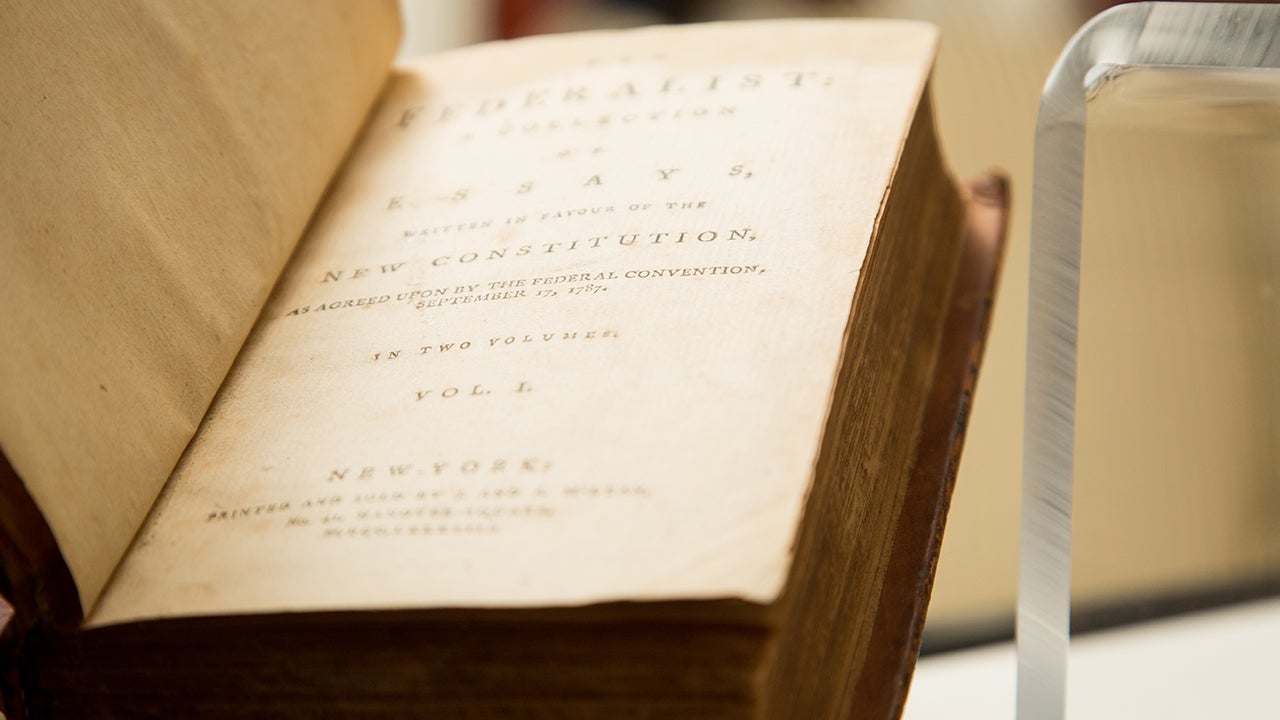
Politics
The Federalist Papers
10 lessons
7h total length
Create Your Account to Get Instant Access to “The Federalist Papers”
Discover the Genius of the Constitution
Lessons in this course

33:05
lesson 1
Introduction: Articles of Confederation and the Constitutional Convention
Written following the Constitutional Convention of 1787, The Federalist Papers is the foremost American contribution to political thought. Originally published as newspaper essays in New York, they were written by Alexander Hamilton, James Madison, and John Jay under the pen name Publius. The essays defended the merits of the Constitution as a necessary and good replacement for the Articles of Confederation, which had proven defective as a means of governance.

30:55
lesson 2
The Improved Science of Politics
Publius argued that the “science of politics . . . has received great improvement” in his own day. These improvements include separation of powers, legislative checks and balances, judges who serve a life term during good behavior, and what he called “the ENLARGEMENT of the ORBIT” of government. Contrary to the practice of previous republics, Publius argued that a republic had a much greater chance of achieving success if it is spread out over a large or extended territory, rather than a small or contracted one.

29:15
lesson 3
The Problem of Majority Faction
In Federalist 10, Publius confronts one of the most important Anti-Federalist arguments against ratification: Republican government is impossible on a territory as large as the United States. In fact, such an undertaking had never been successful. In response, Publius proposes that the principal remedy for the political disease of faction—a disease “most incident to republican government”—is the large or extended sphere or territory.

27:30
lesson 4
Federalism and Republicanism
In the summer of 1787, the Framers labored to set up a political regime that would not only secure liberty and republicanism, but also bring energy and stability to the national government. Because of the failures of government under the Articles of Confederation, American political institutions were at risk. In order to secure these institutions, the Framers constructed a republican form of government that—among many other important features—instituted a new form of federalism.

27:46
lesson 5
Separation of Powers
In constituting a new government, the Framers knew that written rules—what Publius calls “parchment barriers”—would not be enough by themselves to protect liberty and prevent tyranny. Instead, Publius looks to the “interior structure” as the best means for keeping the branches properly and effectively separated. Separation of powers, the most important of the Constitution’s “auxiliary precautions,” works to prevent governmental tyranny, and by keeping each branch within its proper sphere of authority allows each branch to do its job well.

29:40
lesson 6
The Legislative: House and Senate
The Founders understood that the legislative branch is by nature the most powerful in a republican government. Experience of government under the Articles of Confederation, when state legislatures routinely encroached on executive and judicial powers, confirmed this. Thus, the Framers divided the legislative branch into two parts—the House and the Senate. In addition, they differentiated them as much as possible, consistent with the principles of republican government, with the goal of preventing tyranny and encouraging good government.

35:14
lesson 7
The Executive
Following their experience under the Articles of Confederation, and armed with the improved science of politics, the Framers instituted a unitary executive in the office of the president. Unlike the executive office in any previous republic, it was designed so as to ensure energy and responsibility in the executive, which are absolutely essential for good execution of the laws, and therefore for good government.

29:38
lesson 8
The Judiciary
In the Declaration of Independence, one charge leveled against King George III was that he had “made Judges dependent on his Will alone.” In framing a republican government, the Founders believed that an independent judiciary was indispensable. Publius argues that the term of life tenure during good behavior and a protected salary ensure this independence.

25:54
lesson 9
“The Constitution Is Itself . . . a Bill of Rights”
In Federalist 84, Publius writes, “The truth is, after all the declamation we have heard, that the constitution is itself, in every rational sense, and to every useful purpose, A BILL OF RIGHTS.” In other words, the structure of the Constitution protects the rights of the people. In addition, the American people retain all powers not granted to the federal and state governments.

31:53
lesson 10
Conclusion: Constitutionalism Today
American government today is much different from the constitutional republic outlined in The Federalist Papers—which relies on structure, representation, and limitations on the functions of the federal government. Administrative regulations and entitlements are two distinguishing features of modern government. These new features require a kind of government that is unlimited, disregards separation of powers, and violates the supreme law under which it claims to operate.
Enroll in "The Federalist Papers" by clicking the button below.
What Current Students Are Saying
The instructors are very good. The tests make you think. There are other helpful discussion screens and the whole process makes it feel much like a classroom setting. I feel the Federalist Papers are somewhat difficult to read on your own, so this course makes it much easier to understand.
Create your FREE account today!
All you need to access our courses and start learning today is your email address.